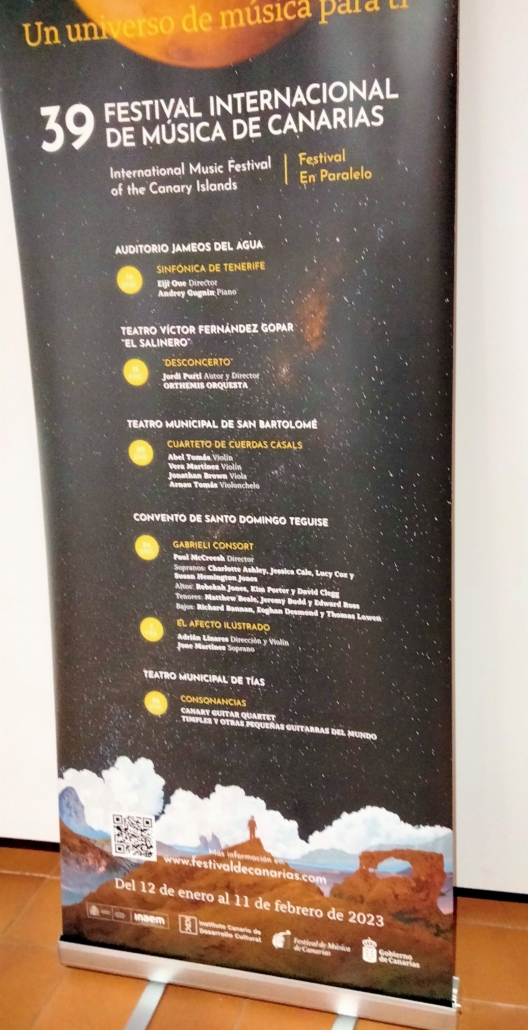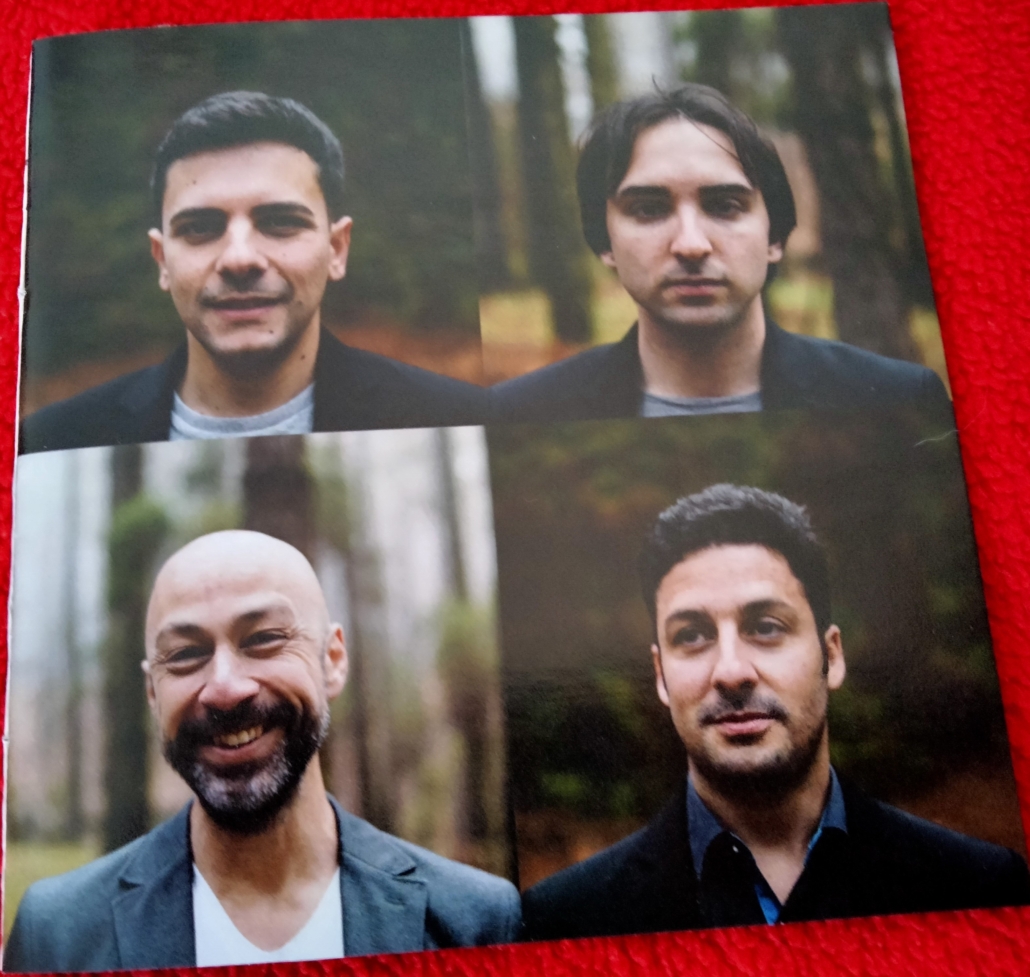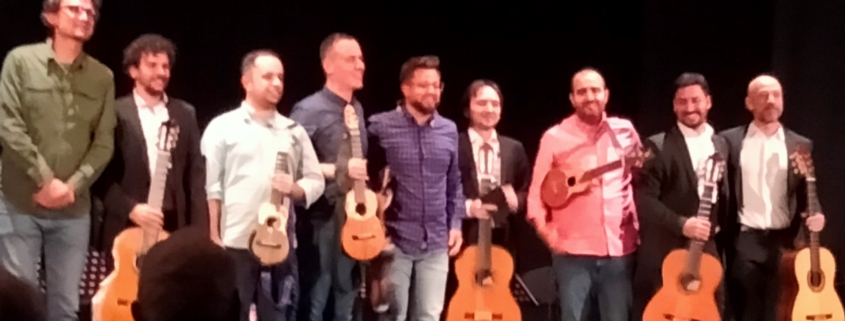TIMPLES AND LITTLE GUITARS make Consonannces
TIMPLES AND LITTLE GUITARS
39th Canary Islands Music Festival
Consonnances at Santo Domingo Convent Teguise
January 2023
reviewed by Norman Warwick

‘Consonancias’ was the title of this show that brought together two traditional groups at the En Paralelo Festival : the Canary Guitar Quartet and Timples and Other Little Guitars of the World . These are two projects with different conceptions that, totalling more than 50 strings in the hands of its 9 performers, transported the audience on a journey through time and space, delving into music from different eras and styles: classical, jazz, folk and world music. The show closed with the world premiere of a joint work, written for the occasion, through which not only revealed the high-quality level of performance of the musicians on stage, but also reminded us that this family of instruments is more alive than ever.
Tonight´s event was another instalment of The Annual Canary Islands International Classical Music Festival, of which 2023 is the 39th edition.
The logistics of this must be mind-bogglingly complex.: artist recruitment, diaries, itineraries, venues, dates, personnel, instruments for full orchestras, a press campaign across the eight islands.
Orchestras, groups and their instruments cross-cross the seas for six weeks with each of the islands being offered the opportunity to see major players. Every island gets it share with slight adjustments made to cater for the smaller islands. Lanzareote have six concerts this year, some of which we have already reviewed reviewed here on Lanzarote and we have tickets for those that remain.
It is, of course, a fatastic opportunity for these world lass musicians to demonstrate their skills and share the music they love.
That was certainly the case here tonight..
ARTISTIC SHEET
Canary Guitar Quartet
Samuel Delgado / Luis Alejandro García / Tomás Fariña / Fran Yanes (guitars) Timples and other small guitars of the world
Germán López / Derque Martín / Beselch Rodríguez / Yone Rodríguez (timples)
Leandro Ojeda (double bass)

PROGRAM
Canary Guitar Quartet playing
Bantu ( by Andrew York)
Quiccan (by Andrew York)
Canaries (by Fran Yanes)
Timples and other Little Guitars of the World playing
Tanganillo (by German Lopez)
Bolivian (by Machado)
96th Stafford (by Jose Antonio Ramos)
Swing (by Benito Cabrera)
Venezuelan (by Yone Rodríguez)
Folías/folíasswing (Popular / Althay Páez)
Canary Guitar Quartet + Timples and other Little Guitars of the World playing
Libertango (by Astor Piazzolla)
Consonances (by Fran Yanes)
Alive (Popular / Fran Yanes)

I never thought I would attend a classical concert and hear echoes of an album by the late Americana singer writer John Stewart (left), but the players tonight evoked distant traces of Centennial, one of two guitar instrumental albums the singer songwriter released on a home produced label to great acclaim even from the audience that had already loyally bought his dozen or so sole singer-writer albums.
John Stewart was a former member of The Kingston Trio, who later saw The Monkees take his Daydream Believer to the top of the pop charts, and Roseanne Cash ride his Runaway Train to the top of the country charts and she very nearly enjoyed another top hit with his To Dance With The Tiger.
John enjoyed his own top ten chart hit with his song about (People Out There Turning Music Into) Gold. John was ´Americana´ when country was still called country and western.
This was all brought to mind by the Canary Guitar Quartet in the opening set of this wonderful concert. The show was part of a classical concert, and they played classical music, with a classic Spanish feel, but stormed across any musical borders on their way that might have denied them entry.
I heard Blues, I heard Western Swing and I heard John Stewart and, unless I´m being fanciful (it happens!) I heard Aaron Copland in his jazz and folk phases.
The playing by The Canary Guitar Quartet was incredible: punctual, (meaning all instruments arrived at the same place at the right time), precise, and with perfect placements of highs and lows.

The song I couldn´t get out of my head during this first set was one written by the late Steve Goodman (right) in the seventies that celebrated a string trio, Martin Bogan Armstrong that delivered brilliant versions of songs like The Ice Cream Parlour Blues, and if you think that all sounds a long way from classical,….it isn´t. Folk, country blues, classical and folk-lore music from various places all live together in what Leonard Cohen might have called The Tower Of Song, and they are pretty close neighbours.

Violinist, storyteller, and philosopher Howard Armstrong was a member of the remarkable African-American string band Martin, Bogan & the Armstrongs. In their prime, Virginia-born guitar and mandolin blues artist Carl Martin, guitarist Ted Bogan, and string player Howard Armstrong, the group enjoyed multiple incarnations, starting in the 1930s as the Four Keys, then morphing into the Tennessee Chocolate Drops and then the Wandering Troubadours, before they stuck with the name Martin, Bogan & the Armstrongs.(left) They played individually and collectively throughout the mid-South on the radio, at medicine shows, and at country jukes before eventually making it to Chicago in the late ’30s and ’40s, where they made records but mostly supported themselves by what Armstrong calls “pulling doors.” This meant going into different cafes and taverns and playing for tips if they weren’t thrown out. Playing various ethnic neighbourhoods, the group took advantage of Armstrong‘s gift with languages and learned to sing in a variety of tongues. Best-described as an acoustic string band (violin, guitar, mandolin, bass), the group played blues, jazz, pop, country, and various non-English favourites. As skilled musicians eager to earn tips by playing whatever their audiences wanted, they built up a large repertoire.
Having gone their separate ways, the group reunited as Martin, Bogan & the Armstrongs in the early ’70s and enjoyed substantial blues revival acclaim.
After Carl Martin died, Bogan and Armstrong continued — the duo were still the greatest living exponents of the African-American string-band style, equally at home playing blues, swing, jazz, ragtime, and older Black string band material. Armstrong, who spoke seven languages, was a National Heritage Award winner in 1990. What made trio’s music so wonderful — in addition to their energy, flawless presentation, and their personable good humour — was their ability to remind audiences that good music transcends classifications and a skilled artist can draw from many streams.
How incredible it was for me tonight to witness a new generation carrying forward the music they love, and playing it with synchronicity and syncopation.

The first set by The Canary Guitar Quartet (right) of Samuel Delgado, Luis Alejandra Garcia, Tomas Farina and Fran Yanes (CGQ as they are known) included two exquisite pieces, Bantu and Quiccan, both composed by Andrew York and a composition from CGQ player, Fran Yanes, entitled Canarios.
After loud and prolonged applause the foursome ceded the stage to the not quite so snappily named Timples y Otres Pequanas Guitarras del Mundo.

The stage was, however, now owned by an ensemble equal quality.of German Lopez on Timp`le Contra, Derque Martin on Timple, Beselch Rodriguez who would play Timple and Timple Baritone as well as Ukelele Baritone and Ukelele and Charange, Yone Rodriguez, player of Timeple, Charango, Ukelele, acoustic guitar, Cavaquinho and Timple baritone Leandro Ojeda on Contrabajo, which looked like an ultra-modern electric double bass. Timples And Little Guitars (left) made wonderful music..
This was still classical music, albeit played on a number of different stringed instruments and their performance ncluded a lively Vaiven, composed by much loved musician, Benito Cabrera, an artist we have on these pages many times. Check out our easy to navigate archives of over 800 pieces, to learn more about him.
There was also a popular traditional piece, adapted by Althay Paez.
Drawing from six composers altogether the performers created a contemporary sound built around the other-worldly electric bass, of constantly changing tempo and mood.
It was when the two ensembles combined for the final third of the programme .that we offered the fantastic Libertango by Astor Piazzolla and two works by Fran Yanez with the eponymous and very popular Consonancias. The closing number, also by Yanes, was called Vivo and lived up to its title in a lively fashion..
Again, though, the American music I love seemed evident in this section of the event. The music evocative of the kind of jazz/blues fusion employed as backing for the fairground hustler vocals of writer / poet / singer Tom Waits but played, perhaps, with a gentler attitude that would have been required for Waits´ recordings.
As you can see form our photograpsh, we bought a cd by each ensemble on the way out, after a fantastic concert. At the merchandise we met Beseleh Rodrigues of Timples Y Otras Pequenas Guitarras del Mundo- We exchanged cards and made arrangements to conduct an exclusive interview when this Festival is completed.
Watch this space !




Leave a Reply
Want to join the discussion?Feel free to contribute!